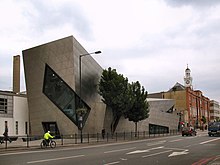Holloway, London
Others believe the name derives from Hallow and refers to the road's historic significance as part of the pilgrimage route to Walsingham.
No documentary evidence can be found to support either derivation;[1] and by 1307, the name Holwey was applied to the district around the road.
By the 14th century it was in such poor condition that the Bishop of London built a new road up Highgate Hill and was claiming tolls by 1318.
The London and North Eastern Railway opened a station here, which had a significant impact on the residential and commercial development of the neighbourhood in the latter part of the 19th century.
Stopes opposed abortion; she tried to discover alternatives for families and increase knowledge about birth control and the reproductive system.
[3] During the Second World War, parts of Holloway experienced intense bombing due to its proximity to King's Cross railway station.
In addition, Islington London Borough Council have earmarked many improvement projects for the Nag's Head area over the next decade.
Near to Holloway Road tube station is the North Campus of London Metropolitan University.
[4][5][6] Arsenal Football Club moved after 93 years at Highbury to a new stadium at Ashburton Grove in Holloway.
All of Islington's waste is shipped here for onward processing - together with a significant proportion of that generated by the neighbouring London Boroughs of Camden and Hackney.
Drayton Park railway station is near the southern end of Holloway Road, and is on the Northern City Line.

